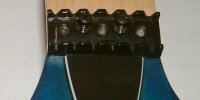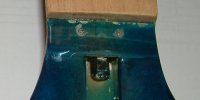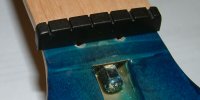The Blueshifter was perfect in every way except for one. The open high E string would drone like a sitar. I determined that this was due to the locking nut: Either the angle was wrong, or the slot mis-shaped, or a combination.

The problem was still apparent after switching from 9’s to 10’s, and I started thinking about purchasing a replacement locking nut. But then I got to thinking: The Blueshifter is fitted out with sperzel locking tuners – string pegs that actually clamp on to the string. Even though guitars with Floyd Rose trems usually come standard with locking nuts for tuning stability, is the locking nut really necessary?

Several people on the Carvin Guitar BBS have said that it is not: A decent, regular low-friction graphite nut should be just fine if the guitar has sperzels. Seeing as I was planning on replacing the nut anyway, I figured I had nothing to lose by giving it a try. A few clicks and four bucks later and the Carvin online web store was shipping me a regular graphite nut. And yesterday it arrived in the mail.

Removing the current locking nut was easy. It’s attached to the neck by a couple of screws. After I removed the nut I realised several things that should have been obvious: Firstly, the truss rod access cover plate is somewhat shorter for guitars fitted with locking nuts; Secondly, the locking nut sits on a flat area of the headstock parallel to the neck, while the rest of the headstock tilts back at the usual angle; and finally, the new graphite nut was a “blank” in that it was generously sized and would need to be filed and sanded into optimum shape for the guitar.

And hence begins a tale of mistakes that I am reticent to relate. Let’s just say that for a while I wish I’d ordered two nuts!
I used 230 grit sandpaper to put a slight angle on the nut – then realised it was going to slope the wrong way – then corrected it – then wondered if it was now too short to adequately lift the strings away from the frets. Then I had the bright idea of using superglue to fasten the nut in place. Oy. I must have been crazy. I actually realised the risk and problems associated with this decision yet somehow my arms and hands didn’t get the signal and plopped the nut perfectly into place – which promptly slipped sideways and stuck! Talk about locking nuts. At the very last possible instant my brain got its act together and I flicked the nut off the neck with my thumbs. The traces of glue on the nut were easily removed with some careful additional sanding.
I used a couple of blobs of PVA to secure the re-finished nut in place. I might want to remove it later on, and the strings themselves will hold the nut against the neck. I had a spare regular-sized truss rod cover to use, and although the remaining exposed flat region where the locking nut was located is still detectible, it doesn’t bother me.
So far, it seems to be a success. As far as I can tell with this new set of strings, the tuning is quite stable, even after fairly agressive tremelo action.
Leave a Reply